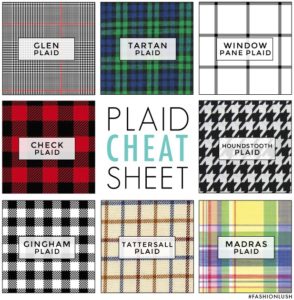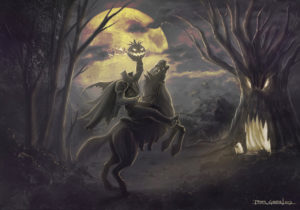‘Tis the season for plaid–Yes, we are all mad for it. But there are so many plaids to choose from. And what exactly is the difference between a plaid and a check? Do you know which plaids look best on YOU? Have you ever thought about it?

Lovely reader Janet requested information on plaid, so I became intrigued. Little did I know, there’s a lot more to these colorful geometric prints than I ever imagined.
In the United Kingdom, “plaid” actually refers to the fabric, not the pattern. And if you are of British descent, your family (clan) might even have its own signature tartan.


But in the U.S., plaid is simply used in a generic way to mean a “patterned material.” How well do you know your plaids? HERE’S A CHEAT SHEET FOR YOU.

As you can see, some plaid patterns are bold (check plaid), some have lots of contrast–dark/light (houndstooth), some are more colorful (Madras), and some are quite subtle (glen plaid).
On page 21 of Quintessential Style, we talk about the scale of prints and patterns. Of course, you can wear any plaid, but which plaid would be the most flattering for your color type?
The thing to remember about plaid is, you never want to wear a plaid pattern that overwhelms you so much that you become a “headless horseman.”
“Headless Horseman” is a style term coined by my co-author, Janna Beatty. It means wearing a garment that so completely overpowers (or diminishes) your personal coloring, that your face becomes invisible–and all you see is the outfit.
For example: If you close your eyes, then open them quickly, what is the first thing you see in this photograph? The model’s face, or her buffalo check?

This orange plaid is certainly the first thing I see here. The poor girl has become a ‘headless horseman.’

These guys are wearing such subtle patterns, with only slight contrast, the plaid isn’t actually overwhelming them, even though it’s head to toe.

And those royals sure have their plaids down:

So as you can see, there are a plethora of plaids to choose from.
I love this black and white buffalo check chair in my kitchen, but I would never wear this pattern because it has too much contrast for my fair coloring. It would completely overpower me.


But, I never fail to get compliments when I wear this ivory, window-pane print coat. Why? Because the background is light and the pattern is not too strong.
When you really begin to look at yourself closely in plaids, checks, and patterns, you will discover that some are definitely more flattering on you than others.
Don’t become the dreaded “headless horseman.” Wear your plaids wisely.







4 Comments
You’ve taken me back to my childhood with this column about plaids, Sharon. I wore a lot of plaid as a child and teen. My mother used to make most all my clothes and she was a whiz at matching plaids. I also had a beautiful plaid Pendleton suit she bought me when I was in high school. It was a lovely blue with a pink accent. I need to look at plaid in a new way – after reading your book of course! Now that I’m retired (as of 5 days ago) I need a new image!
Molly,
What a sweet memory of your mom and growing up. It seems we could wear a lot of things when we were younger and our color was still intact. And most of us could wear black with no problem, but it doesn’t seem to work as well as we age.
I think we need to think of a new word for “retirement.”
Maybe you can create a more clever one.
I too grew up wearing plaid skirts with a matching solid color sweater on top. Now I’m afraid of how the plaid would accentuate my rear end. I need to shop for a more muted plaid.
Oh, youth! We never appreciated what we could wear when we were young.
Thanks for your idea on plaid, Janet.